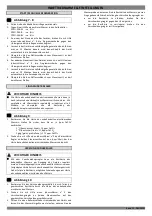
PRECAUTIONS & INTRODUCTION
Page 3 - ENGLISH
GENERAL
Read this guide carefully
. Failure to follow the instructions
contained in this guide:
1.
will render the warranty null and void
.
2.
could cause personal injury or damage to the device or the
property, for which the manufacturer cannot be held
responsible.
If you have any questions or remarks, contact your Delta supplier
before you begin with the installation of the device.
Keep this guide in a safe place and make sure that new users are
familiar with the content.
Make sure you have all necessary tools on hand before you begin
with the installation of the device.
Follow all local legal regulations.
INTENDED USE OF THE DEVICE
The device is intended to remove hardness ions (calcium,
magnesium) from cold drinking water; it will not remove other
contaminants present in the water!
The device is primarily intended for residential applications;
during the regeneration of one unit, the other unit remains in
service and provides softened water.
INSTALLATION OF THE DEVICE
The device must be installed on a flat, stable base.
The device must be installed indoors, protected from direct
sunlight.
The device must be installed on a dry location and certainly not in
an acidic environment.
Do not install the device close to a heating source; the ambient
temperature must be below 40 °C (104 °F).
Protect the device and all of its hydraulic connections against
frost.
FUNCTIONING
This device is a water softener that removes hardness from the
incoming water. It functions according to the principle of ‘ion
exchange’.
In service mode it exchanges the hardness-ions calcium (Ca) and
magnesium (Mg) by sodium (Na). At the start of the service cycle the
ion exchange resin beads inside the device are loaded with sodium-
ions; because the ion exchange resin has a preference to attract
calcium- and magnesium-ions, the resin beads, when hard water
flows through the device, release their sodium-ions to the water and
in return replace them by calcium- and magnesium-ions. This ion
exchange process continues until all sodium-ions on the resin beads
are replaced by calcium- and/or magnesium-ions; at that point the
resin beads are ‘saturated’ and need to be regenerated.
In regeneration mode the ion exchange process is reversed. The brine
cabinet, which contains regeneration salt (NaCl = sodium chloride), is
automatically filled with a specific amount of water, which dissolves
a specific amount of regeneration salt to form a brine solution. This
brine solution is sucked up by the control valve by means of a vacuum
and flows over the saturated resin beads inside the device, to the
drain. During this ‘brining cycle’ the ion exchange process is reversed
thanks to the excessive concentration of sodium-ions present in the
brine solution; the resin beads release their calcium- and magnesium-
ions to the rinse water and replace them by sodium-ions again. When
one unit of the device is in regeneration, the other unit remains in
service and provides softened water.
The device functions solely by the hydraulic pressure of the incoming
water supply; therefore, it has no electrical components, like power
transformers, motors, switches or cables. All moving parts inside the
device are brought into movement by the water pressure only.
SCOPE OF DELIVERY & MAIN COMPONENTS
⊷
Illustration 1
①
Bypass valve (¾” male BSP)
②
Control valve
③
Resin tank
④
Brine cabinet
⑤
Brine valve
⑥
Inlet port of control valves
⑦
Outlet port of control valves
⑧
Hardness blending regulator
⑨
Inlet hardness regulator
⑩
Brine valve connection with quick-connect fitting 4 mm to T-piece
⑪
Drain connection
⑫
Communication tubes
⑬
Brine valve connection T-piece with quick-connect fitting 4 mm
Содержание DTSO-200-B
Страница 7: ...Page 7 ENGLISH ...
Страница 13: ...Page 13 FRANCAIS ...
Страница 19: ...Seite 19 DEUTSCH ...
Страница 25: ...Pagina 25 NEDERLANDS ...
Страница 26: ......
Страница 27: ......
Страница 28: ...Delta Water Engineering NV Waesdonckstraat 1 2640 Mortsel Belgium www deltawaterengineering com ...




































